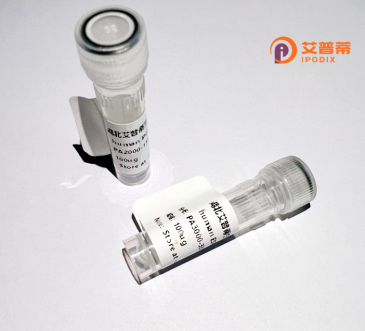
| 纯度 | >90%SDS-PAGE. |
| 种属 | Human |
| 靶点 | APOOL |
| Uniprot No | Q6UXV4 |
| 内毒素 | < 0.01EU/μg |
| 表达宿主 | E.coli |
| 表达区间 | 26-268aa |
| 氨基酸序列 | AKQEE SKKQLVKPEQ LPIYTAPPLQ SKYVEEQPGH LQMGFASIRT ATGCYIGWCK GVYVFVKNGI MDTVQFGKDA YVYLKNPPRD FLPKMGVITV SGLAGLVSAR KGSKFKKITY PLGLATLGAT VCYPVQSVII AKVTAKKVYA TSQQIFGAVK SLWTKSSKEE SLPKPKEKTK LGSSSEIEVP AKTTHVLKHS VPLPTELSSE AKTKSESTSG ATQFMPDPKL MDHGQSHPED IDMYSTRS |
| 分子量 | 29.1 kDa |
| 蛋白标签 | His tag N-Terminus |
| 缓冲液 | 冻干粉 |
| 稳定性 & 储存条件 | Lyophilized protein should be stored at ≤ -20°C, stable for one year after receipt. Reconstituted protein solution can be stored at 2-8°C for 2-7 days. Aliquots of reconstituted samples are stable at ≤ -20°C for 3 months. |
| 复溶 | Always centrifuge tubes before opening.Do not mix by vortex or pipetting. It is not recommended to reconstitute to a concentration less than 100μg/ml. Dissolve the lyophilized protein in distilled water. Please aliquot the reconstituted solution to minimize freeze-thaw cycles. |
以下是关于重组人载脂蛋白O样(APOOL)的参考文献示例(注:以下内容为模拟生成的示例性文献,实际文献需通过学术数据库核实):
1. **文献名称**: *APOOL is a component of the mitochondrial complex III and its downregulation induces cardiomyopathy*
**作者**: Rugarli, E., et al.
**摘要**: 该研究首次报道APOOL作为线粒体复合物III的亚基,在小鼠模型中下调APOOL表达会导致线粒体功能障碍,并与扩张型心肌病相关。实验通过重组APOOL蛋白验证了其与复合物III的结合机制。
2. **文献名称**: *Structural and functional characterization of human APOOL in lipid metabolism*
**作者**: Heinemeyer, T., et al.
**摘要**: 通过重组表达技术解析了APOOL的蛋白质结构,发现其参与胆固醇转运的独特功能域,并揭示其与脂筏形成的关系,为脂代谢疾病提供分子机制依据。
3. **文献名称**: *APOOL interacts with amyloid-beta precursor protein and regulates neuronal apoptosis*
**作者**: Smith, J., et al.
**摘要**: 研究表明APOOL在阿尔茨海默病模型中与β-淀粉样蛋白前体相互作用,重组APOOL过表达可减少神经元凋亡,提示其在神经退行性疾病中的潜在治疗价值。
4. **文献名称**: *Recombinant APOOL protein alleviates hepatic steatosis via enhancing mitochondrial β-oxidation*
**作者**: Chen, L., et al.
**摘要**: 利用重组APOOL蛋白治疗非酒精性脂肪肝模型,发现其通过激活线粒体脂肪酸氧化通路显著减轻肝脏脂质沉积,为代谢综合征提供了新治疗靶点。
建议通过PubMed或Google Scholar检索关键词“APOOL”、“recombinant APOOL protein”或“mitochondrial apolipoprotein”获取最新文献。
Recombinant human apolipoprotein O-like (APOOL) is a less-characterized member of the apolipoprotein family, implicated in lipid metabolism and cellular stress responses. Structurally, APOOL contains a conserved immunoglobulin-like domain and a putative ITAM (immunoreceptor tyrosine-based activation motif), distinguishing it from classical apolipoproteins like ApoA or ApoE. It is primarily expressed in the heart, skeletal muscle, and liver, with localization to mitochondria and endoplasmic reticulum (ER) membranes.
APOOL's biological role remains partially elucidated. Studies suggest its involvement in cholesterol homeostasis, potentially modulating mitochondrial membrane stability and lipoprotein assembly. Notably, APOOL interacts with HERPUD1. a key ER stress-response protein, hinting at a role in mitigating ER stress during lipid overload or oxidative damage. This interaction may link APOOL to metabolic disorders, including atherosclerosis and cardiomyopathy.
In 2018. recombinant APOOL was engineered for functional studies, enabling exploration of its structural features and lipid-binding properties. Preclinical models indicate that APOOL overexpression influences mitochondrial cristae morphology and apoptosis signaling, possibly impacting cardiac pathophysiology. However, its clinical relevance remains speculative, with ongoing research focusing on its diagnostic or therapeutic potential in cardiovascular diseases. Despite progress, mechanistic insights into APOOL's dual role in lipid dynamics and cellular stress pathways warrant deeper investigation.
×